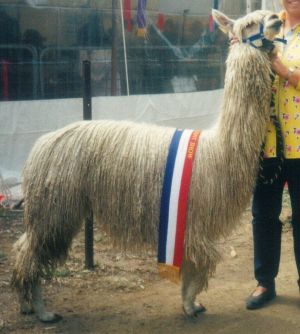About Suri Alpacas
It is known from archaeological records that alpacas have been domesticated for 6,000 years.
Early depictions of suri alpacas dating from between 5 and 20 thousand years ago can only be found on the western slopes of the Andean mountains in Peru. The suri appears as a distinct breed in early textiles, pottery and jewellery.
The word suri originates from the Aymara language and refers to the lustrous quality exhibited by the feathers of the ostrich. Suris evolved from the very fine fleeced vicuna and the fibre was so treasured by Incan rulers that it was reserved exclusively for their use. Any offender was punishable by death! Suri fibre has since gained the reputation of being one of the silkiest fibres available.
Suri alpacas can be distinguished from the huacaya by their exotic, flowing dreadlocks in contrast to the fleece of the huacaya which grows straight out from the skin. The suri carries a silky, high lustre and dense fleece which drapes from a parting along the spine and moves freely and often likened to a curtain of silk. Both animals are anatomically the same with the only difference being the fleece type.
The rare suri represents only 6 % of the national herd but is widely gaining popularity amongst breeders who are starting to realise the potential use and demand for the luxurious fibre in the top fashion houses of Europe and other fashion conscious areas such as interior design fabrics and textiles. International designers rate vicuna and suri as the best fibre in the world.
There are now an increasing number of homozygous suri sires available which, as the suri gene is dominant, makes it possible to breed suri progeny from huacaya dams. The majority of suris are white, the most commercially sought after colour, however some breeders are introducing colour into their suri herd by cross breeding their suri males with coloured huacayas to produce some spectacular results.
There are four styles of suri fleece
- Type 1 The Tight Lock - the fleece forms tight ringlets all the way down from the skin
- Type 2 The Fanned Lock - the fleece begins at the skin as a fan shape and then twists into a ringlet.
- Type 3 The Curled Lock - bold curls that hang in corkscrew like ringlets
- Type 4 The Straight Fleece - the fleece parts along the backline and hangs straight down from the body with no twist to the lock.
As the suri has an open fleece along its backline, it is able to tolerate the harsh heat of the Australian summers quite well, whilst extreme cold and rain in winter does necessitate some sort of simple shelter against the elements. The suri fleece is generally quite even in micron and lacks medullation thus the whole fleece, with the exception of the lower legs and belly, can be utilized making sorting at shearing time quite labour saving. As the alpaca does not need to be slaughtered to harvest its fleece, the fibre has been called green fur.
Quote 
"Suris are the rather unlikely looking possessors of the finest, shiniest and most desirable dreadlocks that, until lately, were the well - kept secret of the high Andes!"


